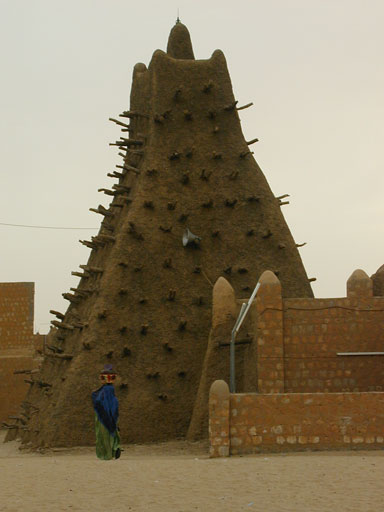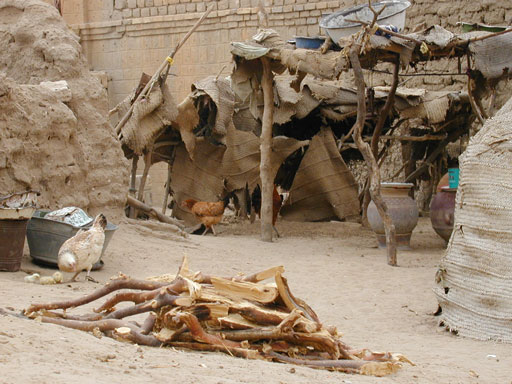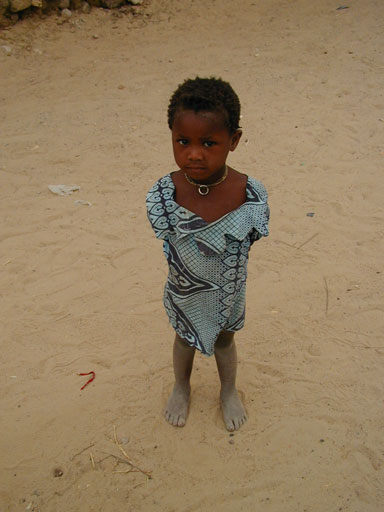- Date
- 4 April 2000
- Lodging
- Hotel Bouctou
- Distance
- 907 KM
- Total
- 67481 KM
Finally we made our way to mysterious, fabled Timbuktu. I remember when Jim and I talked of making this world journey; Timbuktu was one of the few required stops for us. Now that we visited, we understand why more people don’t get to the no-man’s land. Getting there ain’t easy by any stretch of the imagination.
The closed local airport means people arriving by air must fly to Goundam and then ride an old, decrepit bus 100 kilometers to Timbuktu and those driving cars face pretty horrible terrain of continuous sand dunes and uneven, rocky piste. (A few words of advice: Wear your seatbelt or be thrown from the car and don’t think of attempting to drive without four-wheel drive. Wear dark clothes since you’ll be covered in sand and dirt upon arrival in Timbuktu.)
We found a room in the Bouctou Hotel, although we had to move to another when the first one came complete with Agama, orange-headed lizards. I can sleep in horrible heat with a mosquito net almost suffocating me, but I don’t want to share the bed, walls or floor with lizards. Evidently seeing my dismay, the Bouctou manager moved us to the cleaner wing complete with toilet and toilet seat (They do not always come with the latter.), toilet paper, towel and an air conditioner, which worked 50 percent of the time. No hot water in the bath; in fact, there was only one spigot for cold water.
During the afternoon we explored the sandy streets of up-until-now unobtainable Timbuktu. Djinguereber Mosque, dating back to the fourteenth century and the oldest of three remaining large mosques in Timbuktu, won my favor. The Sahel-style mud architecture ensures an impressive site and the wooden spikes protruding from the façade add the to the aesthetic appeal, yet they are functional, not decorative. They become scaffolding after rainy season when the townspeople replace any mud that has been washed away. Fortunately for them Timbuktu’s rainy season is short and not severe. Inside Djinguereber Mosque I touched stones that men rubbed to cleanse their hands (ablution) when water was not available in the village. We visited the room where women are allowed to worship, but only after they have successfully made the Haj to Mecca.
Just beyond the colorful, outdoor market is another Sahel-style mosque. Sankore Mosque was built in the fifteenth century as a mosque and university where as many as 25,000 students studied theology and law during the sixteenth century. Today Sankore is only a working mosque and the local children must head to Bamako for university although few leave now. Outside Sankore is an enormous square where I could have watched for hours the women, shepherds and children. In particular the women – statuesque, draped in colorful fabrics covering themselves in customary Islamic fashion. And the shepherds wearing their traditional blue and white boubous, which look much like comfy nightgowns.
Legendary Timbuktu knew great richness from salt caravans, gold deposits and the slave trade from as early as the Crusades through the seventeenth century. Today camels still carry salt – up to four enormous slabs on each of the more than 100 camels in a caravan. Timbuktu claims about 20,000 people now compared to 100,000 during peak years. During our visit, children and young people appeared to be more than half the population. Even though their playground is the desert, the children laugh, tug at one another and always try to shake my hands offering with the sweetest smiles, “Bonjour Madame,” over and over again.
Jim and I both savored every moment of the slow-paced, 38-degree C (100-degree F) desert day in Timbuktu – not the thriving, bustling, rich center of 500 years ago, but still an enchanting town worth every effort in getting there.







